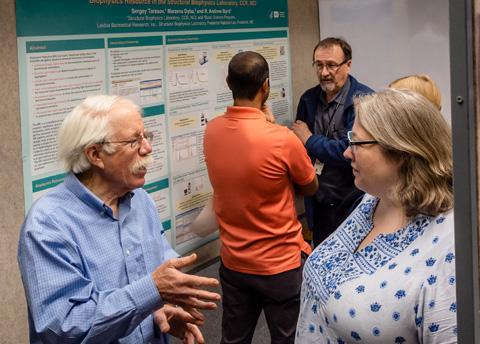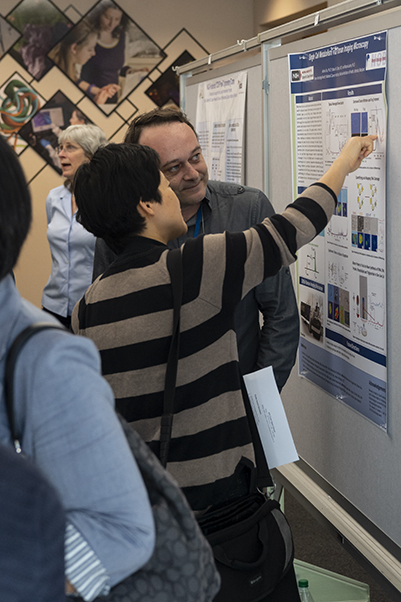The lobby of Building 549 at NCI at Frederick bustled with activity for two hours on Tuesday, May 1, as several dozen scientists and staff gathered for the NCI Core Open House.
The event aimed to encourage discussion and educate visitors about the capabilities of the cores, laboratories, and facilities that offer support to NCI’s Center for Cancer Research (CCR). Accordingly, representatives from 24 groups collectively displayed 30 posters detailing their cores’ current projects, available services for CCR investigators, and plans for future partnerships.
One such individual was Lixin Fan, Ph.D., senior scientist, Structural Biophysics Laboratory, who works in the Small Angle X-ray Scattering Core Facility. More accurately, she is the Small Angle X-ray Scattering Core—the only employee assigned to run the facility under the direction of Yun-Xing Wang, Ph.D., senior investigator, Structural Biophysics Laboratory.
Fan’s poster outlined previous examples of her work, which she drew upon to describe the facility’s abilities. She enthusiastically explained that the core uses small angle X-ray scattering to study biological structures and molecules, such as DNA, RNA, and proteins. While it’s fundamentally different from other techniques like crystallography, it has several advantages because it allows scientists to examine interactions and flexible structures that can’t be encapsulated with crystals.
Similarly, the facility offers advantages outside of the laboratory. Fan doesn’t simply provide resources for experiments; she also runs the experiments and helps clients to analyze their data and prepare their resulting manuscripts for publication.
However, Fan quickly added that small angle X-ray scattering has limitations in areas where other cores’ technologies excel. It’s a situation that exemplifies the relationship between the cores—they indirectly work together to offer a gamut of capabilities so scientists can make use of the advantages of each as they’re needed.
Other representatives paralleled Fan’s levels of expertise and enthusiasm. Many warmly greeted passersby and invited them to learn more about the services available through their cores, ranging from the bioinformatics of the Advanced Biomedical Computing Center to the sample cryopreservation of the Clinical Support Laboratory to the molecular diagnostics of the Genomics Technology Laboratory.
In most cases, the representatives’ efforts were rewarded with a receptive audience. Some visitors scribbled in notebooks during their conversations, while others snapped photographs of the information on the posters.
Individuals who missed the open house and wish to learn about the cores’ services can find more information on the NCI Office of Science and Technology Resources’ website.



